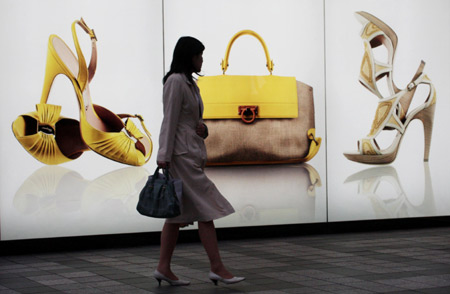Top Biz News
Chinese chic steps up to the catwalk
By Yu Tianyu (China Daily)
Updated: 2010-01-11 08:00
 |
Large Medium Small |
|
 |
|
Chinese fashion designers are finding their work to be in increasing demand. [Agencies] |
The Devil along with countless Chinese people may wear Prada but there is a growing feeling that the world's second-biggest consumer of luxury goods could start looking closer to home for fashion accessories.
China is on the verge of fielding high-end fashion that can compete with anything coming out of Paris, New York, London or Milan, say observers.
"It is very likely to be the next birthplace of another luxury brand because of the country's cultural history, booming market and a big number of talented designers," said Luee Sun, a London-based buyer who purchases fashion items for department stores.
From Dec 1, 2007, to the end of January 2009, China consumed $8.6 billion in luxury goods, surpassing the US last year to become the second largest luxury goods market in the world behind Japan, according to the US-based World Luxury Association (WLA).
A forecast from Bain & Co showed a stronger-than-expected rise in luxury sales for Asia, especially China, amid the worst ravages of the financial crisis. It predicted in 2009 luxury-goods sales in the Chinese mainland would jump by 12 percent from a year earlier.
However, the road ahead will be long and hard for fledgling Chinese fashion gurus competing with Western rivals, say experts.
"During my previous job I was always being asked to contribute some Chinese elements and inspirations to the western design pieces. Chinese characteristics are increasingly being used in all kinds of luxury products, ranging from clothes to jewelry," Wu said. "I was wondering why we didn't create a Chinese luxury brand by leveraging our own history and culture."
As she spoke, Wu took off her favorite Armani suit and Hermes scarf, put aside her Chanel handbag and changed into the hoodie and sneakers more favored by dispossessed youth.

The young woman visits a wholesale fabric market at least twice a week seeking inspiring materials.
"The market is chaotic and buying materials is really a fight," Wu said. "Good fabric at appropriate prices is always in strong demand. When I find it I grab it and press the money into the seller's hand."
Wu opened a six-square-meter store called "Red" at Dongsi, in Beijing's Dongcheng district, selling the clothes and accessories that she designs. It's a far cry from the 200-sq-m studio she used to work in.
Every day, Wu has to argue with tailors, asking them to obey her designs precisely on every detail and burn the midnight oil to adjust garments stitch by stitch.
The average price of a "Red" brand designer piece is about 1,000 yuan but, despite the cost, Wu has won a great number of fans.
She said: "All luxury brands started with a small workshop and I will contribute my talent and life to create the history of my brand."
"However, it requires a long time to develop the philosophy behind a new brand. Furthermore, it will take generations to gain the worldwide acceptance of designers, the fashion media and, of course, fashion enthusiasts. It is the same for all luxury brands."
Kevin Yeung, chairman of Hong Kong Fashion Designers, said China shouldn't rush into the business of luxury branding because of the length of time it takes to build up popularity and reliability among consumers, encouraging them to accept the brand's philosophy and inevitable high prices.
Unlike Daisy Wu, middle-aged Ji Pingsheng, also known as Mouse Ji after his designer suits, is further advanced in the luxury goods business.
Ji was the first Chinese designer to have his brand sold at the Galleries Lafayette, the top luxury department store in Paris, France. The "little mouse" products are displayed next to those of Liu Jo, Armani and many other examples of design "royalty". Ji proudly says Mouse is one of the best sellers.
Ji has opened more than 600 stores across Europe and many top luxury department outlets have courted him.
"Ji is the family name I inherited from my ancestors while Mouse is the year I was born. I tend to integrate the two Chinese cultural symbols into my brand," said Ji, who majored in the art of porcelain at university. "However, pure Chinese elements cannot gain global popularity: You need to go international."













